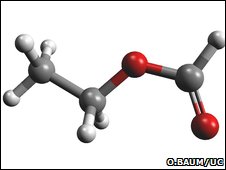Complex molecules seen in space By Paul Rincon Science reporter, BBC News, Hatfield Astronomers have detected two of the most complex carbon-rich molecules ever found in interstellar space. Their models suggest even more complex await to be discovered, including amino acids - which are essential for life. The results were presented at the European Week of Astronomy and Space Science meeting being held in the UK. Researchers detected the organic molecules in the star-forming region of space known as Sagittarius B2, close to the centre of our galaxy. Large carbon-rich molecules of many different types have been seen in this cloud in the past, including alcohols, aldehydes, and acids. The two new molecules - ethyl formate and n-propyl cyanide - were found in a hot, dense cloud of gas which contains a luminous newly formed star. They represent two different classes of molecule: the esters and alkyl cyanides. Atoms and molecules emit radiation at different frequencies, which appear as characteristic lines in the light "spectrum" from an astronomical source. "The difficulty in searching for complex molecules is that the best astronomical sources contain so many different molecules that their 'fingerprints' overlap, and are difficult to disentangle," says Arnaud Belloche, from the Max Planck Institute for Radio Astronomy in Bonn, Germany. "Larger molecules are even more difficult to identify because their fingerprints are barely visible: their radiation is distributed over many more lines that are much weaker," adds Holger Mueller, researcher at the University of Cologne. Out of 3,700 spectral lines detected with the IRAM telescope in Spain, the team identified 36 lines belonging to the two new molecules. The astronomers then ran computational models to understand how molecules like these form in interstellar space. They could be built up atom-by-atom via collisions of gaseous particles. Alternatively, atoms could meet and react on small grains of dust suspended in the interstellar gas. As a result, the grains build up thick layers of ice, composed mainly of water, but also containing a number of basic organic molecules like methanol, the simplest alcohol. Their computational models suggest the largest molecules form section-by-section, using pre-formed building blocks already carried by the dust grains. The new molecules seem to be "born" in this way, via a series of short steps that build up long-chain molecules. "There is no apparent limit to the size of molecules that can be formed by this process - so there's good reason to expect even more complex organic molecules to be there, if we can detect them," says Robin Garrod, an astrochemist from Cornell University in Ithaca, New York, US. Astronomers believe it could only be a matter of time before amino acids are found in interstellar space. This class of molecules is needed for the production of proteins, and are therefore essential for life. In the past, researchers have looked for the simplest amino acid, glycine, without any luck.
|
